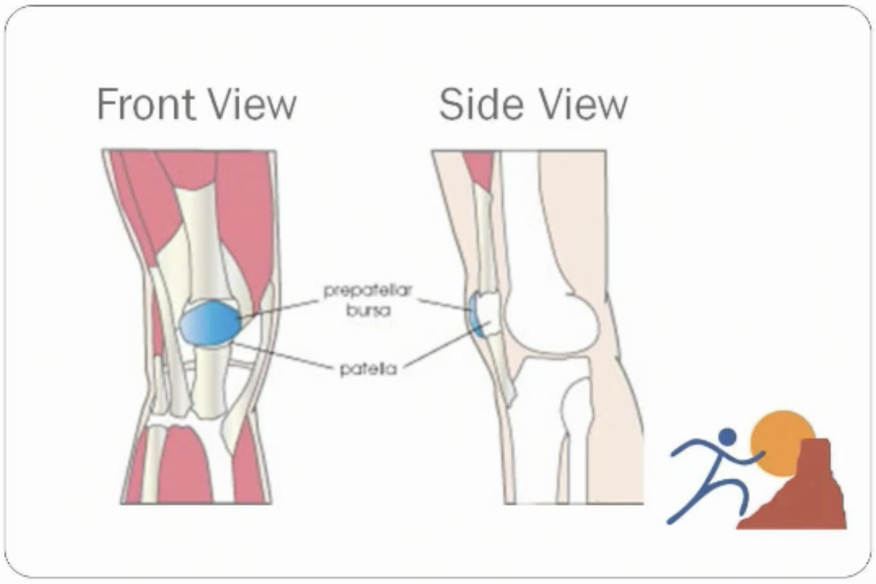Knee Bursitis
August 18, 2022
Hello and welcome to Yuma Health and Happenings. I’m Dr. Ron Clark, Orthopedic Surgeon and founder of The Bone and Joint Center of Yuma. Today I want to talk about a rather common problem called bursitis involving the knee. Most people have heard of this term but may not be well informed of the cause or treatments available when it occurs in the knee.
The Knee and Bursa
The knee is formed by the thigh bone, called the femur, and a lower leg bone called the tibia. The knee joint can be compared to a rocking chair that moves back and forth to allow for bending and straightening. This joint consists of bone and is covered by a softer tissue, known as cartilage, which cushions and lubricates the bones during movement. Between the two major bones of the knee is the kneecap, or patella, that connects the front muscles of the thigh to the front of the shin bone.
In between the kneecap and the skin is a special layer of tissue called the patellar bursa. A bursa is a type of tissue that is like a balloon and has about ¼ of a teaspoon of fluid in it. This fluid allows the bursa to act as a friction pad over the bone and under the skin. With the bursa in place, the skin is protected from the pressure that the bone exerts. We have all seen a shirt or jeans that have worn a hole over the front of the knee or the back of a sleeve. This hole develops because of the increased pressure over the elbow and knee as it bends.
Knee Bursitis Symptoms
Normally the bursa is hardly noticeable around the knee and simply allows the skin to slide easily over the front of the knee. As the knee bends backwards, the skin over the front of the knee must be able to stretch and allow the knee to flex. This stretching of the skin increases the pressure mechanically over the knee.
The term “bursitis” refers to inflammation that occurs inside of the bursa due to pressure, friction, repetitive use, or a sudden fall. Bursitis can also occur due to infection that can invade the area by going through the skin or after a penetrating injury. Those who work on their hands and knees are particularly at risk for this problem that has been called “carpet layer’s knee” because of frequent involvement with that occupation.
The main symptom of knee bursitis is swelling in the bursa which is situated over the front of the knee. Pain may or may not be present, depending on the cause and type of bursitis. Bursitis from repetitive use is frequently non-painful, while bursitis from a puncture wound may be infected, reddened, and quite painful. The more the knee is swollen, the harder it is for the knee to bend. It is also possible for an infected bursa to open and begin draining pus.
Treatments for Knee Bursitis
If the swelling is painful then care should be sought right away because antibiotics or surgical drainage may be necessary. It is not a good idea to try to drain the fluid of the bursa at home because many patients have made matters worse by doing so.
There are several things that you can do on your own to overcome non-infected knee bursitis. Avoiding deep flexed positions, kneeling, or any situations that tightens the skin over the front of the knee. Over the counter anti-inflammatory medications like naproxen or ibuprofen can be used as well. You might also apply either gentle heat or cold over the swelling with the knee in a straightened position.
Recovery from a swollen knee bursa can takes weeks or months to resolve but as long as the condition is not painful then there is no hurry to try more advanced treatments. Where there is pain, there is a chance that there is either an infection or it could be a form of gout.
In either case, it will be necessary to see a physician so a sample of the fluid in the bursa can be obtained and sent to a laboratory for evaluation. When there is not an infection, cortisone is frequently injected to reduce the production of bursal fluid caused by the inflammation. Several injections may be necessary over a couple of months to get the problem resolved.
Formal surgical care is generally reserved for infections and especially those that have been present for a week or more before being identified. Even with surgery, recovery is generally several weeks and there must be a limitation on the amount of bending permitted at the knee for the wound to completely heal.
Occasionally surgery is needed to remove a non-infected bursa that has not responded to the treatments mentioned previously. This has been rare in my experience but, when necessary, the body is able to re-form a new bursa after the removal. Like many medical problems, the earlier knee bursitis is identified, lifestyle changes made, medications used, and unwise self-treatments avoided, the sooner an individual will recover and the more likely the symptoms will resolve without the need for surgery.